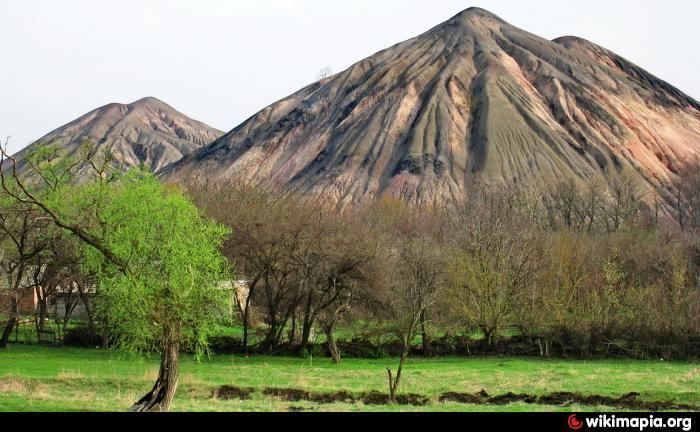 | ||
France s most unique ski resort a spoil tip
A spoil tip (also called a spoil bank, boney pile, gob pile, bing, batch, boney dump or pit heap) is a pile built of accumulated spoil – the overburden or other waste rock removed during coal and ore mining. These waste materials are typically composed of shale, as well as smaller quantities of carboniferous sandstone and various other residues. Spoil tips are not formed of slag, but in some areas they are referred to as slag heaps.
Contents
- France s most unique ski resort a spoil tip
- A view from bersham colliery spoil tip rhostyllen
- Physical description
- Environmental effects
- Subterranean combustion
- Landslip
- Re use
- Examples
- References
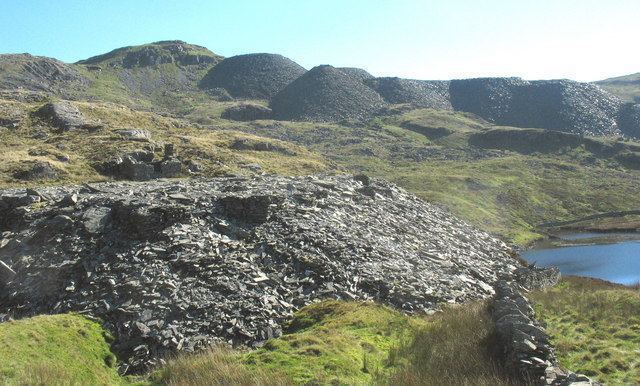
The term "spoil" is also used to refer to material removed when digging a foundation, tunnel, or other large excavation. Such material may be ordinary soil and rocks, or may be heavily contaminated with chemical waste, determining how it may be disposed of. Clean spoil may be used for land reclamation.
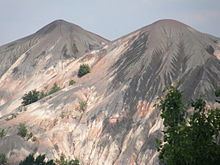
Spoil is distinct from tailings, which is the processed material that remains after the valuable components have been extracted from ore.

A view from bersham colliery spoil tip rhostyllen
Physical description
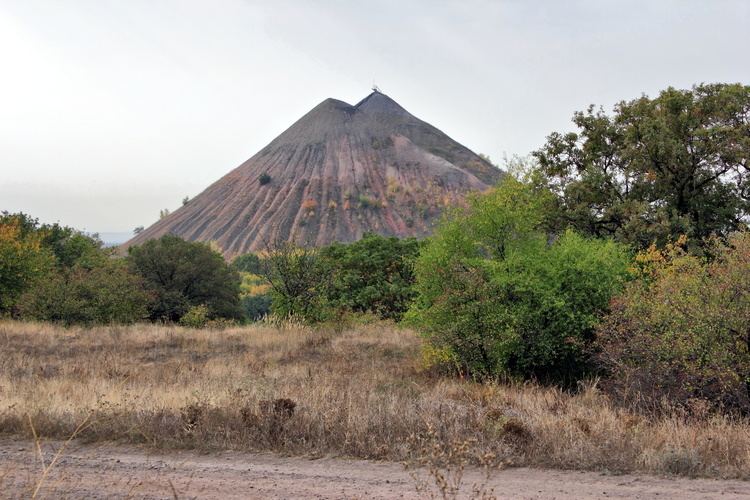
Spoil tips may be conical in shape, and can appear as conspicuous features of the landscape, or they may be much flatter and eroded, especially if vegetation has established itself. In Loos-en-Gohelle, in the former mining area of Pas-de-Calais, France, are a series of five, very perfect cones, of which two reach 180 metres (590 ft), surpassing the highest peak in Flanders, Mont Cassel.
Environmental effects
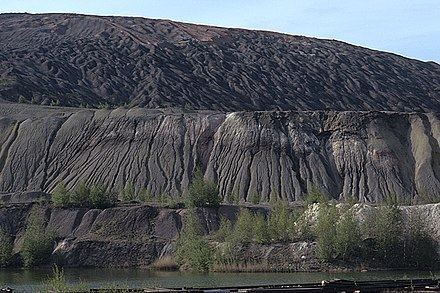
Spoil tips sometimes grew to millions of tons, and, having been abandoned, remain as huge piles today. They trap solar heat, making it difficult (although not impossible) for vegetation to take root; this encourages erosion and creates dangerous, unstable slopes. Existing techniques for regreening spoil tips include the use of geotextiles to control erosion as the site is resoiled and simple vegetation such as grass is seeded on the slope.
The piles also create acid rock drainage, which pollutes streams and rivers.
Subterranean combustion

As some spoil tips resulting from industries such as coal or oil shale production can contain a relatively high proportion of hydrocarbons or even coal dust, they can commence spontaneous subterranean combustion, which can be followed by surface fires. In some coal mining districts, such fires were considered normal and no attempt was made to extinguish them.
Such fires can follow slow combustion of residual hydrocarbons. Their extinction can require complete encasement, which can prove impossible for technical and financial reasons. Sprinkling is generally ineffective and injecting water under pressure counter-productive, because it carries oxygen, bringing the risk of explosion.
The perceived weak environmental and public health impact of these fires leads generally to waiting for their natural extinction, which can take a number of decades.
Landslip
With spoil tips there is a danger of landslip. An example was the Aberfan disaster in Wales 1966, in which a total 144 people were killed, 116 of whom were school children, mostly between the ages of 7 and 10. Five teachers also died in the accident. In February 2013, a spoil tip was the cause of a landslip which caused the closure of the Scunthorpe to Doncaster railway line while repairs were carried out.
Re-use
Several techniques of re-utilising the spoil tips exist, usually including either geotechnics or recycling. Most commonly, old spoil tips are partially revegetated to provide valuable green spaces since they are inappropriate for building purposes. At Nœux-les-Mines, an artificial ski slope has been constructed on the tip. If spoil tips are considered to contain sufficient amounts of residual material, various methods are employed to remove the spoil from the site for subsequent processing.
The oldest coal-based spoil tips may still contain enough coal to begin spontaneous slow combustion. This results in a form of vitrification of the shale, which then acquires sufficient mechanical strength to be of use in road construction. Some can therefore have a new life in being thus exploited; for example, the flattened pile of residue from the 11/19 site of Loos-en-Gohelle. Conversely, others are painstakingly preserved on account of their ecological wealth. With the passage of time, they become colonised with a variety of flora and fauna, sometimes foreign to the region. This diversity follows the mining exploitation.
For example, because the miners threw their apple or pear cores into the wagons, the spoil tips became colonised with fruit trees. One can even observe the proliferation of buckler-leaved sorrel (French sorrel – Rumex scutatus), the seeds of which have been carried within the cracks in the pine timber used in the mines. Furthermore, on account of its dark colour, the South face of the spoil tip is significantly warmer than its surroundings, which contributes to the diverse ecology of the area. In this way, the spoil tip of Pinchonvalles, at Avion, hosts 200 different varieties of higher plants. Some thirty species of birds nest there.
Some cultivate vines, as in the case of Spoil Tip No. 7 of the coal-mining region of Mariemont-Bascoup near Chapelle-lez-Herlaimont (province of Hainaut) which produces some 3,000 litres of wine each year.
Some spoil tips provide for various sporting activities. The slopes of the spoil tips of 11/19 at Loos-en-Gohelle, or again, at Nœux-les-Mines, are used for winter sports, for example ski and luge, since the provision of a piste on the flank of the heap. In Belgium, a long distance footpath along the spoil tips (GR-412, Sentier des terrils) was opened in 2005. It leads from Bernissart in western Hainaut to Blegny in the province of Liège.
In the United States, mining companies have not been allowed to leave behind abandoned piles since the Surface Mining Control and Reclamation Act was passed in 1977.
Examples
One of the highest, at least in Western Europe, is in Loos-en-Gohelle in the former mining area of Pas-de-Calais, France. It comprises a range of five cones, of which two reach 180 metres (590 ft), surpassing the highest peak in Flanders, Mont Cassel. One of the regions of Europe most "littered" with (mountainous) spoil heaps is the Donbass, in Ukraine, especially around the city of Donetsk, which alone boasts about 130 of them. In Ukrainian, they are called terikony (in the singular: terikon).
In Heringen, Hesse, Germany, is the popularly called "Monte Kali", made of spoil from potash mining and rising some 200 meters above the surrounding terrain. "La Muntanya de Sal" (The Salt Mountain), another potash mine spoil heap, lies in Cardona, Catalonia, at about 120 meters in height. A larger and higher pile is that of "El runam del Cogulló" (The Spoil Heap of El Cogulló), also known as "El runam de la democràcia" (The Slag Heap of Democracy) or "Montsalat" (Salty Mountain), in Sallent, which has already grown higher than the small mountain it was named after (El Cogulló, 474 meters above sea level).
